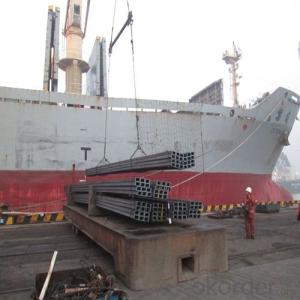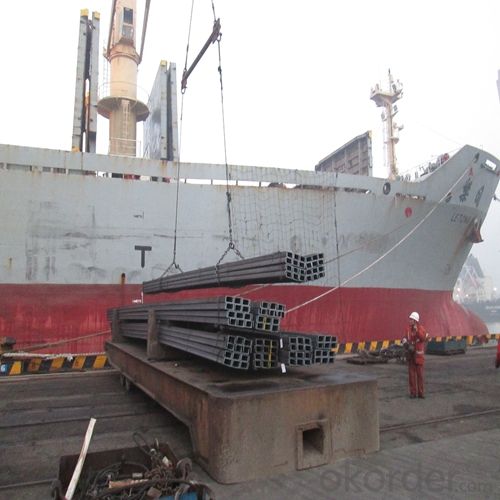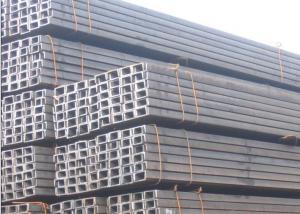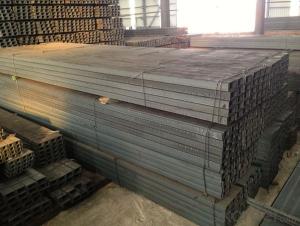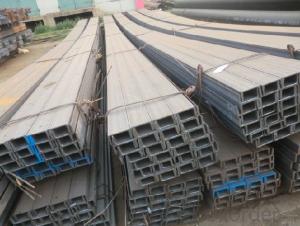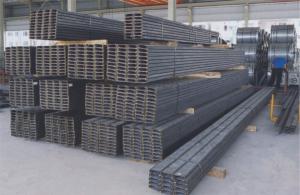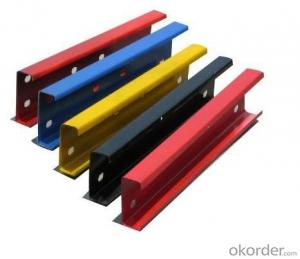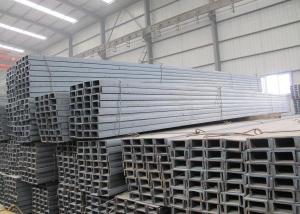Hot Rolled Structure Steel U-Channel JIS Standard GB Standard
- Loading Port:
- Tianjin
- Payment Terms:
- TT OR LC
- Min Order Qty:
- 100 m.t.
- Supply Capability:
- 30000 m.t./month
OKorder Service Pledge
OKorder Financial Service
You Might Also Like
Product Description:
Steel U Channel Details:
Minimum Order Quantity: 25 Tons Unit: m.t. Loading Port: Xingang Port
Supply Ability: 1000 Tons Per Day Payment Terms: TT or L/C
Product Description:
Specifications of Steel U Channel:
Standard Applied: GB Standard, EN Standard(UPN), JIS Standard
Sizes: 50mm to 300mm
Material Grade: Q235B, Q345B, S235JR, SS400, ASTM A36
As shown in the figure:
| JIS U CHANNEL | Standard h | Sectional b | Dimension s | t | Mass: Kg/m |
| (mm) | (mm) | (mm) | (mm) | ||
| 50x25 | 50 | 25 | 3.0 | 6.00 | 2.37 |
| 75X40 | 75 | 40 | 3.8 | 7.00 | 5.30 |
| 75X40 | 75 | 40 | 4.0 | 7.00 | 5.60 |
| 75X40 | 75 | 40 | 4.5 | 7.00 | 5.85 |
| 75X40 | 75 | 40 | 5.0 | 7.00 | 6.92 |
| 100X50 | 100 | 50 | 3.8 | 6.00 | 7.30 |
| 100X50 | 100 | 50 | 4.2 | 6.00 | 8.03 |
| 100X50 | 100 | 50 | 4.5 | 7.50 | 8.97 |
| 100X50 | 100 | 50 | 5.0 | 7.50 | 9.36 |
| 125X65 | 125 | 65 | 5.2 | 6.80 | 11.66 |
| 125X65 | 125 | 65 | 5.3 | 6.80 | 12.17 |
| 125X65 | 125 | 65 | 5.5 | 8.00 | 12.91 |
| 125X65 | 125 | 65 | 6.0 | 8.00 | 13.40 |
| 150x75 | 150 | 75 | 5.5 | 7.30 | 14.66 |
| 150x75 | 150 | 75 | 5.7 | 10.00 | 16.71 |
| 150x75 | 150 | 75 | 6.0 | 10.00 | 17.90 |
| 150x75 | 150 | 75 | 6.5 | 10.00 | 18.60 |
3. The chemical composition of HR Channel Steel according to Q235B is shown in Table-2.
Alloy No | Grade | Element(%) | ||||
C | Mn | S | P | Si | ||
Q235 | B | 0.12-0.20 | 0.3-0.7 | ≦0.045 | ≦0.045 | ≦0.3 |
Table-2
Note: we are able to present our customers relevant SGS test report for chemical composition of HR Channel Steel.
4. The mechanical property of HR Channel Steel according to Q235B is shown in Table-3-1 and Table-3-2
Alloy No | Grade | Yielding Strength Point(Mpa) | |||
Thickness(mm) | |||||
≦16 | >16-40 | >40-60 | >60-100 | ||
≧ | |||||
Q235 | B | 235 | 225 | 215 | 205 |
Table-3-1
Alloy No | Grade | Tensile Strength(Mpa) | Elongation After Fracture(%) | |||
Thickness(mm) | ||||||
≦16 | >16-40 | >40-60 | >60-100 | |||
≧ | ||||||
G235 | B | 375-500 | 26 | 25 | 24 | 23 |
Usage/Applications of Channel Steel:
Channel Steel is usually used for building structure, vehicle manufacturing and other industrial structure and often used with i beam.
In details, the channel steel belongs to carbon structural steel which is applied to in the field of construction and machinery. The channel steel is usually used for arch-itechtural structure, and they could be welded in order to support or hang a vari-ety of facilities. They are also usually used in combination with I beam. Generally,the channel steel must possess perfect welding property, riveting property and mechanical property and so on.
Package & Delivery of Channel Steel:
The steel u channel will be packed in bundle with steel wire at each end of every bundle and color marking in order to help the customer to recognize his goods more easily at sight.
And steel u channel could be loaded into 20ft or 40ft container, or by bulk cargo. If the weight of each bundle reaches less than 3.5 mt, the loading by break bulk cargo should be choosed. When the weight of each bundle reaches less than 3mt, the loading by container should be choosed.
As for the transportaion from mill to loading port, the truck will be usually used. And the maximum quantity for each truck is 40mt.
- Q: Are steel channels suitable for the power generation industry?
- Yes, steel channels are suitable for the power generation industry. Steel channels provide strong structural support and can withstand the heavy loads and forces commonly found in the power generation industry. Additionally, steel channels offer excellent durability and resistance to corrosion, making them ideal for long-term use in power plants and other power generation facilities.
- Q: Channel 10 is calculated, if the price per metre is calculated
- On the market, the sale of 10 channel steel, a lot less than the national standard weight, the general negative difference in 5% within the standard. Depending on your use requirements, the maximum negative difference may be as high as 30%.
- Q: What direction does channel steel use best?
- There are N kinds of support: both ends of the simple support, both ends fixed, cantilever, one end of the cantilever, the other end of a simple support, cantilever at both ends
- Q: How do steel channels perform in earthquake-prone areas?
- Steel channels perform well in earthquake-prone areas due to their high strength and ductility. They can effectively absorb and distribute seismic forces, providing enhanced resistance to structural damage. Additionally, steel channels can be designed to flex and bend during an earthquake, minimizing the risk of collapse and ensuring the safety of buildings and structures in these regions.
- Q: You design expert asked: do barrier 5 meters, how long the channel to bear?
- With 10 channel (GB) between 800 to 1000 longitudinal horizontal laying, select the 5# angle, the middle span up to 7M without support (pillar). Compares the aspect to the full use of meters. With No. 10 square tube pitch 610--810 survived, white painted with the suitable iron staircase is beautiful. The ceiling also save cost, also there are no pillars stairs is a good point. I think I've seen a picture in the post, is to use local square steel tubes do, sensory or good.
- Q: Can steel channels be used in stadium construction?
- Steel channels are indeed suitable for stadium construction. These channels, which are also referred to as steel C-channels or U-channels, are widely utilized in the construction industry due to their robustness, durability, and versatility. In stadium construction specifically, they serve various purposes such as providing support for structural components, framing, creating architectural elements, and enhancing the overall strength of the structure. Steel channels play a crucial role in establishing seating areas, walkways, and staircases within stadiums. Moreover, they offer support for large screens, scoreboards, lighting fixtures, and other equipment essential for stadium operations. By incorporating steel channels into stadium construction, a solid and dependable structure is ensured, capable of enduring the immense loads and stresses typically experienced by stadiums.
- Q: What are the different surface coatings available for steel channels?
- Steel channels have a variety of surface coatings available, each with its own unique benefits and characteristics. Some commonly used surface coatings for steel channels include: 1. Galvanized Coating: This is a widely used surface coating for steel channels. It involves applying a layer of zinc to the steel channel's surface through hot-dip galvanizing. Galvanized coating provides excellent corrosion resistance and protects against rust and environmental factors. 2. Powder Coating: For steel channels that require a decorative and durable finish, powder coating is a popular choice. This process involves applying a dry powder to the steel channel's surface and heating it to form a protective coating. Powder coating offers a wide range of colors and finishes, enhancing both aesthetics and durability. 3. Epoxy Coating: Industrial and commercial applications often require resistance to chemicals, abrasion, and impact. Epoxy coatings are commonly used in these cases. They are applied through a two-part epoxy system, creating a strong and durable protective layer on the steel channel's surface. 4. Paint Coating: Paint coatings are a versatile option for steel channels, offering both protection and customization. Enamel, acrylic, or polyurethane paints can be applied to the steel channel's surface to provide an attractive finish and protect against corrosion and weathering. 5. Stainless Steel Coating: When exceptional resistance to corrosion and harsh environments is needed, stainless steel coatings can be applied to steel channels. These coatings typically contain a high percentage of chromium, which forms a passive layer on the steel's surface, offering excellent protection against corrosion. 6. Polymer Coating: Industries that require a non-stick or low-friction surface often use polymer coatings. These coatings, such as polytetrafluoroethylene (PTFE), create a smooth and resistant surface that reduces wear and prevents the accumulation of debris or contaminants on the steel channel. When selecting a surface coating for a steel channel, it is important to consider the specific requirements and intended use. Factors such as corrosion resistance, durability, aesthetics, and environmental conditions should be taken into account to ensure the appropriate coating is chosen.
- Q: What are the different load distribution methods for steel channels in bridges?
- There are several different load distribution methods for steel channels in bridges that are commonly used in engineering design. These methods help distribute the loads and stresses effectively to ensure the structural integrity and safety of the bridge. 1. Equal Distribution Method: This is the simplest load distribution method where the load is distributed equally among all the steel channels in the bridge. Each channel carries an equal share of the load, resulting in uniform stress distribution. 2. Elastic Load Distribution Method: In this method, the load is distributed based on the elastic properties of the steel channels. The load is distributed in proportion to the stiffness of each channel, considering factors such as the moment of inertia and modulus of elasticity. This method ensures that the channels with higher stiffness carry a larger portion of the load. 3. Influence Line Method: The influence line method is a graphical technique used to determine the distribution of loads on steel channels. It involves analyzing the effects of a moving load on the bridge structure. By plotting the influence lines for different positions of the load, engineers can identify the channels that experience the highest stresses and adjust the load distribution accordingly. 4. Finite Element Analysis (FEA): FEA is a numerical method used to analyze complex structures, including bridges. By dividing the bridge into small elements and solving the governing equations, FEA can simulate the behavior of the structure under different loading conditions. This method allows for accurate load distribution calculations by considering various factors like the geometry, material properties, and boundary conditions of the bridge. 5. Design Codes and Standards: Many countries have specific design codes and standards that provide guidelines for load distribution in bridge design. These codes take into account factors such as the type of bridge, span length, traffic loads, and environmental conditions. By following these codes, engineers can ensure that the load distribution methods used in steel channel bridges meet the safety requirements. It is important to note that the selection of the appropriate load distribution method depends on various factors, including the bridge's design, expected loads, and the desired level of safety. Engineers must carefully consider these factors and use appropriate methods to ensure optimal load distribution and structural performance of steel channel bridges.
- Q: What kind of low carbon steel or medium carbon steel are they?
- Low carbon steelLow carbon steel (low carbon steel) as the carbon content of less than 0.25% of the carbon steel, because of its low strength, low hardness and soft, it is also called the mild steel. It includes most of the ordinary carbon structural steel and some high-quality carbon structural steel, most of which are not used for engineering structural parts without heat treatment. Some of them are used for wear-resistant mechanical parts after carburizing and other heat treatment.The annealed structure of low carbon steel is ferrite and a small amount of pearlite, its strength and hardness are lower, and its plasticity and toughness are better. Therefore, its cold forming property is good, and cold forming can be carried out by curling, bending and stamping. This kind of steel also has good weldability. Carbon content from 0.10% to 0.30% low carbon steel is easy to accept all kinds of processing, such as forging, welding and cutting. It is used to make chains, rivets, bolts, shafts and so on.Low carbon steel is generally rolled into angle steel, channel steel, I-beam, steel pipe, steel belt or steel plate. It is used to make all kinds of building components, containers, boxes, furnaces and agricultural machinery and so on. High quality low carbon steel is rolled into thin board, making deep drawing products such as automobile cab, engine cover, etc., also rolled into bars, used for making mechanical parts of low strength requirement. Low carbon steel is not treated by heat before use. The carbon content is above 0.15%. It is treated by carburizing or cyaniding. It is used for shaft, shaft sleeve, chain wheel and other parts which require high surface temperature and good wear resistance.
- Q: Can steel channels be used for supporting exterior shading devices?
- Yes, steel channels can be used for supporting exterior shading devices. Steel channels are commonly used in construction for their strength and durability, and they can provide a sturdy framework for supporting shading devices such as awnings, canopies, or louvers. The channels can be securely attached to the building's exterior and provide a stable base for the shading device. Additionally, steel channels can be customized and fabricated to meet specific design requirements, allowing for flexibility in the installation of exterior shading devices.
Send your message to us
Hot Rolled Structure Steel U-Channel JIS Standard GB Standard
- Loading Port:
- Tianjin
- Payment Terms:
- TT OR LC
- Min Order Qty:
- 100 m.t.
- Supply Capability:
- 30000 m.t./month
OKorder Service Pledge
OKorder Financial Service
Similar products
Hot products
Hot Searches
Related keywords
